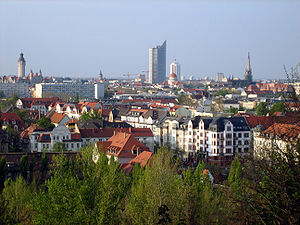Fockeberg
| Fockeberg | ||
|---|---|---|
|
View from Fockeberg to the center of Leipzig (2007) |
||
| height | 153.3 m above sea level NN | |
| location | Saxony , Germany | |
| Coordinates | 51 ° 19 '3 " N , 12 ° 21' 44" E | |
|
|
||
| Type | Rubble | |
| rock | Rubble | |
The name Fockeberg is the unofficial name of the rubble dump Bauernwiesen in the southern suburb of Leipzig .
Emergence
The artificially created mountain with a height of 153.3 m above sea level. NN is located southwest of the intersection of Focke- and Hardenbergstraße. It got its colloquial name from the adjacent street, which was named in 1908 after the merchant August Adolf Focke . Focke bequeathed the capital to the city of Leipzig for several charitable foundations.
The "Fockeberg" started on October 1st, 1947 with the commissioning of a dump to collect rubble on the former farm meadows . From the rubble of the removed ruins, especially from the inner south suburb, an elevation of about 40 meters from the surrounding area was created by backfilling over the course of about ten years.
After the end of the Second World War , a network of rubble tracks began to be laid in the city of Leipzig . The so-called Südbahn first brought rubble to the Dölitz Bruchfeldern on Friederikenstrasse. When this landfill was exhausted, a new landfill was created on the so-called Bauernwiesen in a wooded area that was badly damaged by the air raids on Leipzig . The first transport with rubble was unloaded there on November 3, 1947. The so-called Zentrumsbahn along the Karl-Tauchnitz- , Ferdinand-Rhode- and Wundtstraße, which initially led to the Johannistal , later used the farmer's meadows. After all other landfills for war rubble had been closed in November 1952, only the Bauernwiesen dump remained in operation. This was then used until the end of the rubble railway and beyond. Some of the debris dumped was also recycled. In 1956, for example, larger quantities were transported by truck for the construction of the central stadium . On the north side of the mountain, precast concrete parts were made from treated rubble for a long time.
In the early 1980s, the design and greening of the dump site began. Paths were laid out, seating was created and a total of 15 wooden sculptures were set up, some of which are no longer there. In 1994, as an extension of Hardenbergstrasse, the entrance area was redesigned with a pergola and sculptures by the sculptors Jürgen and Rainer Streege.
Place of rest
Provided with paths for the inspection, the Fockeberg serves today as a place of relaxation and an excellent vantage point. An approximately 850 meter long paved path with a sculpture gallery leads to the top. From the summit, which towers about 40 meters above the surrounding area, there is a good view of the nearby city center, the directly adjacent alluvial forest and the southern parts of the city. Every year the mountain plateau is very popular and usually overcrowded for the midnight New Year's celebration.
In addition, the Fockeberg is the scene of several annual sporting events. Since 1991 the "Fockeberglauf" has started twice a year (on the first Saturday in March and in November). A main run is twelve kilometers (six laps, 270 meters in altitude) and a fitness run over six kilometers (3 laps, 135 meters in altitude).
Once a year two sporting events that are not to be taken very seriously take place, the "Prix de Tacot" and the "Fockeberg time trial". The “Prix de Tacot” organized by the naTo cultural association is an “international” soap box race with the disciplines of mass start (pushing uphill), time trial (one lap on the summit plateau), descent to the foot of the mountain and Engineering League D , in which the teams compete on the mountain plateau and having to build the best vehicle in four hours with unprocessed materials and tools brought with them under the eyes of the audience. In addition to the disciplines, special prizes are awarded, including for the best design and the best juniors. On May 5, 2013, the "Prix de Tacot" took place for the 22nd time.
The "Fockeberg time trial", a cycling race for everyone, was started for the first time on July 3, 2005. It only consists of a mountain classification after a distance of about 850 meters. In 2005 156 drivers and 14 female drivers as well as 10 youngsters started. The winner completed the course in 1:36 minutes. A best time was set in 2008 with 1: 24.89 minutes. The “Fockeberg time trial” was held for the sixth time on June 27, 2010, and in 2011 the race was canceled. The Fockeberg also serves as a popular (short) filming location for films / series such as B. crime scene and in all friendship .
literature
- Christoph Kaufmann: Through the city at full speed. The Leipzig rubble railways 1944–1956. Lehmstedt, Leipzig 2006, ISBN 3-937146-36-9 .
Web links
- Fockeberglauf at Leipziger Triathlon e. V.
- Prix de Tacot - Leipzig Soap Box Race
Individual evidence
- ↑ Gina Klank; Gernot Griebsch: Lexicon of Leipzig street names. Verlag im Wissenschaftszentrum, Leipzig 1995, ISBN 3-930433-09-5 , p. 71.
- ↑ a b Kaufmann: With full steam through the city. P. 29.
- ↑ a b c Kaufmann: With full steam through the city. P. 45.
- ↑ Kaufmann: Full steam ahead through the city. Pp. 29, 122.
- ↑ Kaufmann: Full steam ahead through the city. P. 48.
- ↑ Kaufmann: Full steam ahead through the city. P. 89.
- ↑ Fockeberg time trial e. V .: List of results men 2008 ( Memento from July 11, 2009 in the Internet Archive ) (PDF).




